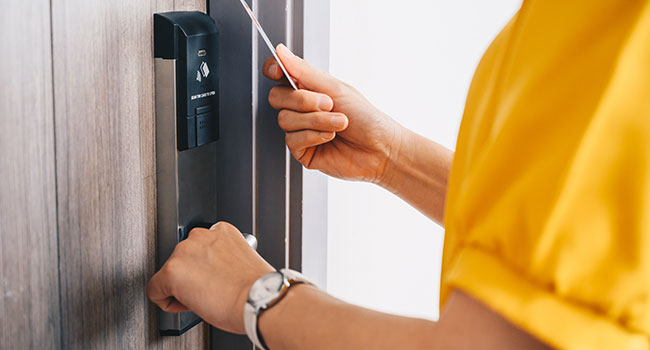
Digital Transformation
Five access control trends to watch for in the coming year
- By Stephen Carney
- Dec 01, 2021
The global pandemic accelerated a worldwide digital transformation that has simultaneously reduced or eliminated physical touchpoints and in-person contact. Meanwhile, today’s definition of physical security has expanded to address the user experience, as access control technologies evolved to enable myriad new building services that can be accessed through people’s mobile phones and other devices. These two dynamics are driving five major trends in access control.
Tapping into touchless technology. As the world reoriented its digital transformation to a touchless experience during the pandemic, this spawned new use cases that benefit from the safety, security, convenience, and efficiency of contact-free interactions with both the physical and digital worlds. Biometrics will be an important addition to this model and advance the security and convenience of these touch-free experiences, from opening doors and printing documents to interacting with connected buildings and digital consumer services, and implementing physical distancing and contact tracing protocols.
Identity is the new perimeter. There had been a change in the workplace even before the pandemic, as secure workplace access is defined less by the workplace physical perimeter. Instead, identity had become the new perimeter. In many cases it is the only perimeter. Protecting this new perimeter requires a new approach that unifies both physical and cyber/IT access through a single physical identity and access management solution. As part of this approach, identity management for a secure, safe, and productive workforce environment requires three key elements: credential management, multi-factor authentication and secure visitor management.
Greater choices for streamlining security. There is growing demand for simple and cost-effective physical security frameworks that support multiple form factors and communication protocols. Physical access cards are a good example. Organizations that choose feature-rich, multi-technology cards can follow a smooth migration path from vulnerable legacy. Also, low-frequency 125 kHz-based systems to a modern and secure technology with multi-application support, at their own pace. Readers also must support this kind of migration path, by supporting the widest possible range of credential technologies. An example is the HID Signo line, which supports HID Mobile Access via native Bluetooth and Near Field Communication (NFC) capability. It also includes Apple's Enhanced Contactless Polling (ECP) application to support credentials in Apple Wallet.
Future-proofing solutions to improve adaptability. An example of the value of solutions that enable organizations to prepare for the future is Vanderbilt University. The institution tapped HID Global in 2014 to help implement a mobile access solution using HID Mobile Access, powered by Seos® credential technology. It was deployed alongside a reader infrastructure comprising HID® Signo™ readers, HID iCLASS SE® readers, and OMNIKEY® desktop readers to manage access to buildings. The university later wanted to add support for credentials in Apple Wallet without compromising the existing access infrastructure or its security. Using HID Reader Manager, this helped to upgrade firmware on the university’s physical access control readers to extend support for NFC-based credentials in Apple Wallet.
Physical ID cards will endure, with inkjet technology expanding personalization options. Nearly 78 percent of respondents in an HID user survey said they would rather be issued both a physical card and mobile ID rather than one or the other. In some environments, such as hospitals, physical photo ID badges are mandatory and must be displayed above the waist for quick visual identification. Not only will physical cards endure, but there will be more choices for producing them.
The latest inkjet printers for industrial card personalization deliver better quality at lower cost than ribbon-based technology, along with easier deployment, upgrades, and maintenance than possible with large central issuance machines. Inkjet technology is also bringing the broader benefits of personalized, secure ID cards to much smaller organizations. They print on the same standard, off-the-shelf polyvinyl chloride (PVC) stock used for most of the world’s corporate IDs and campus cards but replace print ribbons with snap-in ink cartridges that simplify printer use and maintenance while offering more control over per-card costs.
A changing workplace combined with new ways to create, issue, and manage trusted identities will continue to transform access control and enable buildings to become even smarter and more data-driven places. As organizations more tightly integrate access control systems with their advanced smart building solutions, what were previously separate solutions for security and workplace optimization are coming together to reflect the simplicity, scalability and universality of mobile apps. Meanwhile, physical ID cards will continue to play an important role alongside mobile IDs on phones, watches, wristbands and other devices, and will be easier to create and personalize using the latest inkjet printers.
This article originally appeared in the November / December 2021 issue of Security Today.